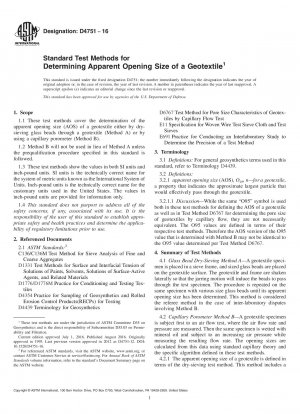ASTM D4751-16
Standard Test Methods for Determining Apparent Opening Size of a Geotextile
- Standard No.
- ASTM D4751-16
- Release Date
- 2016
- Published By
- American Society for Testing and Materials (ASTM)
- Status
- Replace By
- ASTM D4751-20
- Latest
- ASTM D4751-21a
- Scope
5.1 Using a geotextile as a medium to retain soil particles necessitates compatibility between it and the adjacent soil. This test method is used to indicate the apparent opening size in a geotextile, which reflects the approximate largest opening dimension available for soil to pass through.
5.2 Test Methods D4751 for the determination of opening size of geotextiles is acceptable for testing of commercial shipments of geotextiles. Current estimates of precision, between laboratories, have been established.
5.3 Apparent Opening Test results obtained using Method A may differ from test results obtained with Method B. It is the intent of this test method to confirm the equivalency of the Method B results before permitting the use of this alternative. Laboratories electing the use of Method B must first determine any bias that exists between the two methods and document a reliable correlation in accordance with this test method.
5.3.1 The correlation between the Method B results and the Method A results must be established and meet the requirements of this test method for every different geotextile product type tested with Method B. Geotextiles from different manufacturers or with different nominal unit weights are considered different products. A minimum of three test results must be compared with all three satisfying the established correlation.
Note 1: The correlation should be confirmed for a particular product by comparing a minimum of three test results when there are changes in the manufacturing of a specific pre-qualified geotextile.
5.4 In case of a dispute arising from differences in reported test results when using Test Method D4751 for acceptance testing of commercial shipments, the purchaser and the supplier should conduct comparative tests to determine if there is a statistical bias between their laboratories. Competent statistical assistance is recommended for the investigation of bias. As a minimum, the two parties should take a group of test specimens that are homogeneous as possible and that are from a lot of material of the type in question. The test specimens should then be randomly assigned in equal numbers to each laboratory for testing. The average results from the two laboratories should be compared using Students t-test for unpaired data and an acceptable probability level chosen by the two parties before the testing is begun. If a bias is found, either its cause must be found and corrected or the purchaser and the supplier must agree to interpret future test results in the light of the known bias.
5.4.1 In the event that the dispute involves test results produced with the capillary porometer, Method A is considered the referee method for Test Methods D4751.
1.1 These test methods cover the determination of the apparent opening size (AOS) of a geotextile either by dry-sieving glass beads through a geotextile (Method A) or by using a capillary porome......
ASTM D4751-16 Referenced Document
- ASTM C136/C136M Standard Test Method for Sieve Analysis of Fine and Coarse Aggregates
- ASTM D1331 Standard Test Methods for Surface and Interfacial Tension of Solutions of Surface-Active Agents
- ASTM D1776/D1776M Standard Practice for Conditioning and Testing Textiles
- ASTM D4354 Standard Practice for Sampling of Geosynthetics for Testing
- ASTM D4439 Standard Terminology for Geosynthetics
- ASTM D6767 Standard Test Method for Pore Size Characteristics of Geotextiles by Capillary Flow Test
- ASTM E11 Standard Specification for Wire Cloth and Sieves for Testing Purposes
- ASTM E691 Standard Practice for Conducting an Interlaboratory Study to Determine the Precision of a Test Method
ASTM D4751-16 history
- 2021 ASTM D4751-21a Standard Test Methods for Determining Apparent Opening Size of a Geotextile
- 2021 ASTM D4751-21 Standard Test Methods for Determining Apparent Opening Size of a Geotextile
- 2020 ASTM D4751-20b Standard Test Methods for Determining Apparent Opening Size of a Geotextile
- 2020 ASTM D4751-20a Standard Test Methods for Determining Apparent Opening Size of a Geotextile
- 2020 ASTM D4751-20 Standard Test Methods for Determining Apparent Opening Size of a Geotextile
- 2016 ASTM D4751-16 Standard Test Methods for Determining Apparent Opening Size of a Geotextile
- 2012 ASTM D4751-12 Standard Test Method for Determining Apparent Opening Size of a Geotextile
- 2004 ASTM D4751-04 Standard Test Method for Determining Apparent Opening Size of a Geotextile
- 1999 ASTM D4751-99a(2004) Standard Test Method for Determining Apparent Opening Size of a Geotextile
- 1999 ASTM D4751-99a Standard Test Method for Determining Apparent Opening Size of a Geotextile

Copyright ©2024 All Rights Reserved